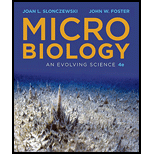
Concept explainers
To review:
The nature of extremophiles and their importance.
Introduction:
Microorganisms are a group of the smallest living organisms that are not visible through naked eyes and the use of microscope is required to see these invisible microorganisms. Microorganisms are present throughout the environment such as in air, water, soil, and also within other living organisms. They are affected by the physical and chemical changes of the environment.
Explanation of Solution
The growth of various microorganisms or microbes is affected by the physical and chemical environment changes and a group of microbes might adapt to various environmental conditions by both temporary and permanent changes. A group of organisms that grows in harsh or extreme environmental conditions is known as extremophiles.
Nature of extremophiles- Extremophile organisms are well adapted to survive in harsh or extreme conditions. For example, a group of microbes such as bacteria and archaea are able to grow in regions where the temperature is above 100 degree Celsius while some other groups are adapted in highly acidic environmental conditions.
Importance of extremophiles- Extremophiles provide a valuable source to study or isolate different forms of proteins that are highly active during extreme conditions such as acidic- basic medium and high or low temperatures. They allow the study of gene expression to view the changes through which the organisms are able to respond in these extreme conditions.
Want to see more full solutions like this?
Chapter 5 Solutions
Microbiology: An Evolving Science (Fourth Edition)
- In a small summary write down:arrow_forwardNot part of a graded assignment, from a past midtermarrow_forwardNoggin mutation: The mouse, one of the phenotypic consequences of Noggin mutationis mispatterning of the spinal cord, in the posterior region of the mouse embryo, suchthat in the hindlimb region the more ventral fates are lost, and the dorsal Pax3 domain isexpanded. (this experiment is not in the lectures).a. Hypothesis for why: What would be your hypothesis for why the ventral fatesare lost and dorsal fates expanded? Include in your answer the words notochord,BMP, SHH and either (or both of) surface ectoderm or lateral plate mesodermarrow_forward
 Comprehensive Medical Assisting: Administrative a...NursingISBN:9781305964792Author:Wilburta Q. Lindh, Carol D. Tamparo, Barbara M. Dahl, Julie Morris, Cindy CorreaPublisher:Cengage Learning
Comprehensive Medical Assisting: Administrative a...NursingISBN:9781305964792Author:Wilburta Q. Lindh, Carol D. Tamparo, Barbara M. Dahl, Julie Morris, Cindy CorreaPublisher:Cengage Learning Biology (MindTap Course List)BiologyISBN:9781337392938Author:Eldra Solomon, Charles Martin, Diana W. Martin, Linda R. BergPublisher:Cengage Learning
Biology (MindTap Course List)BiologyISBN:9781337392938Author:Eldra Solomon, Charles Martin, Diana W. Martin, Linda R. BergPublisher:Cengage Learning





